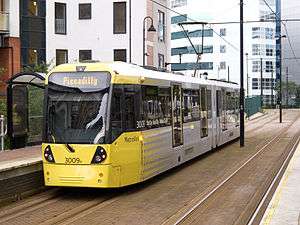Manchester Metrolink
Metrolink (also known as Manchester Metrolink)[note 1] is a light rail tram system in Greater Manchester, England.[8] The system is owned by Transport for Greater Manchester (TfGM) and operated and maintained under contract by RATP Group.[9][10] In 2015–16, 34.3 million passenger journeys were made on the system.[4]
The network consists of seven lines which radiate from Manchester city centre to termini at Altrincham, Ashton-under-Lyne, Bury, East Didsbury, Eccles, Manchester Airport and Rochdale. Metrolink has 93 stops along 57 miles (92 km) of standard-gauge track[11] making it the largest light rail system in the United Kingdom.[12] It consists of a mixture of on-street track shared with other traffic; reserved track, segregated from other traffic, often running alongside the roadway or in the central reservation, and converted former railway lines.[13] It is operated by a fleet of Bombardier Flexity Swift M5000s.
A light rail system for Greater Manchester emerged from the failure of the 1970s Picc-Vic tunnel scheme to obtain central government funding. A light-rail scheme was proposed in 1982 as the least expensive rail-based transport solution for Manchester city centre and the surrounding Greater Manchester metropolitan area. Government approval was granted in 1988 and the network began operating services between Bury Interchange and Victoria on 6 April 1992, becoming the United Kingdom's first modern street-running rail system; the 1885-built Blackpool tramway being the only heritage tram system in the UK that had survived up to Metrolink's creation.[14]
Expansion of Metrolink has been a key strategy of transport planners in Greater Manchester, who have overseen its development in successive projects, known as Phases 1, 2, 3a, 3b and 2CC.[15][16] A second line through Manchester city centre to eliminate the current bottleneck will be operational from early 2017 and work on the Trafford Park Line extension from Pomona to the Trafford Centre is expected to commence in 2016 with an estimated operational date of 2020/21.[17] Furthermore, TfGM have endorsed more speculative expansion proposals for new lines to Stockport, a loop around Wythenshawe, and the addition of tram-train technology.
History
Predecessors
Manchester's first tram age had begun in 1877 with the first horse trams of Manchester Suburban Tramways Company and ceased as early as in 1949, when the last line of the municipal Manchester Corporation Tramways was displaced by motor buses. That company had managed most of the electrification of the trams, executed 1901 to 1903. Since 1938, some trams had been displaced by trolleybuses. Electric traction on tyres in the streets of Manchester ended in 1966.[18]
Origins
A light rail system for Greater Manchester was born of the failure to obtain central government funding for the Picc-Vic scheme linking the existing railway systems north and south of the city centre via a tunnel. Greater Manchester's railway network suffered from poor north – south connections, relying on bus connections through the city centre by means of the Centrelink bus service. Piccadilly and Victoria were built in the 1840s by rival companies on cheaper land on the fringes of the city centre. As early as 1839, in anticipation of the stations being built, a connecting underground railway tunnel was proposed but abandoned on economic grounds,[1][19] as was an overground suspended-monorail in 1966.[20] SELNEC Passenger Transport Executive — the body tasked with improving public transport for Manchester and its surrounding municipalities in the 1960s – made draft proposals for a Picc-Vic tunnel,[21] "a proposed rail route beneath the city centre" forming "the centrepiece of a new electrified railway network for the region".[22] Despite investigatory tunnelling under the Manchester Arndale shopping centre,[22] when the Greater Manchester County Council presented the project to the United Kingdom Government in 1974,[23] it was unable to secure the necessary funding,[24] and was abandoned on economic grounds when the County Council dropped the plans in 1977.[21][23]
In 1982, the Greater Manchester Passenger Transport Executive (GMPTE; the successor to SELNEC PTE) concluded that a street-level light rail system to replace or complement the region's under-used heavy railways was the cheapest solution to improving Greater Manchester's rail transport network. A Rail Study Group, composed of officials from British Rail, Greater Manchester County Council and GMPTE formally endorsed the scheme in 1984.[25] Abstract proposals based on light rail systems in North America and continental Europe,[26] and a draft 62-mile (100 km) network consisting of three lines were presented by the Rail Study Group to the UK Government for taxpayer funding.[21] Following route revisions in 1984 and 1987,[21][27] and a trial on 9 February 1987 using Docklands Light Railway rolling stock on a freight-only line adjacent to Debdale Park,[28] funding was granted by HM Treasury with the strict condition that the system be constructed in phases.[21] Additional taxpayer funding came from the European Regional Development Fund and bank lending.[29]
Phase 1, Bury, Altrincham and Manchester city centre
Conversion of the East Lancashire Railway (Bury-to-Victoria) and Manchester, South Junction and Altrincham Railway (Altrincham-to-Piccadilly) heavy rail lines, and creation of a street-level tramway[30] through Manchester city centre to unite the lines as a single 19.2-mile (30.9 km) network,[31] was chosen for Phase 1 because the two heavy rail lines were primarily used for commuting to central Manchester, and would improve north – south links and access to the city centre.[32][33][34][31] The required parliamentary authority to proceed with Phase 1 was obtained with two Acts of Parliament – the Greater Manchester (Light Rapid Transit System) Act 1988 and Greater Manchester (Light Rapid Transit System) (No. 2) Act 1988.[35]
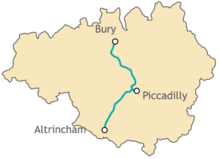
On 27 September 1989, following a two-stage tender exercise, the Greater Manchester Passenger Transport Authority awarded a contract to the GMA Group (a consortium composed of AMEC, GM Buses, John Mowlem & Company, and a General Electric Company subsidiary)[36] who formed Greater Manchester Metro Limited to design, build, operate and maintain Phase 1 of Metrolink.[37] The contract was approved by Michael Portillo on behalf of the Department for Transport on 24 October 1989, and formally signed on 6 June 1990.[37]
The Bury line was closed in stages between 13 July 1991 and 17 August 1991, after which the 1200V DC third rail electrified line was adapted for a 750 V DC overhead line operation.[38] In Manchester city centre, a tramway – built with network expansion in mind[39] – from Victoria to Piccadilly via Market Street and Piccadilly Gardens connected Bury to Altrincham via Manchester. The overhead structures and wiring of the Altrincham line were adapted for light rail.[38] As well as upgrades to signalling and stations on the network, a combined headquarters, depot and control centre was built at Cheetham Hill on Queens Road, north of Victoria station,[38] at a cost of £8 million (£15,500,000 as of 2016[40]).[41]
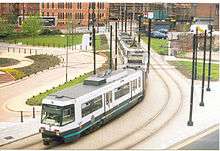
Initially projected to open in September 1991, then promised for 21 February 1992,[42] Metrolink began operation on 6 April 1992 with a service between Victoria and Bury.[43][44] The network was expanded beyond Victoria to G-Mex tram stop on 27 April 1992; a service through to Altrincham joined the network on 15 June 1992,[44] The completion of Phase 1 and enabling use of all 26 T-68 vehicles acquired for the operation.[38][45] Queen Elizabeth II declared Metrolink open at a ceremony in Manchester on 17 July 1992, adding that Metrolink would improve communication between northern and southern Greater Manchester.[45][44][46][45][44]
Then costing £145 million (£270,600,000 as of 2016[40])[29] Phase 1 was expected to carry 10 million passengers per year,[47] but surpassed this figure by the 1993/94 fiscal year, and every year thereafter.[48] By 2003, Phase 1 was deemed a "long-term success" by GMPTE, and, with overcrowding at peak times, carried more than 15 million passengers per year.[49][15]
Phase 2, Salford Quays, Eccles
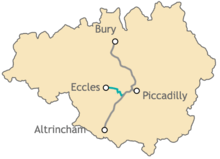
During the 1990s, Salford Quays became a business district specifically redeveloped for commerce, leisure, culture and tourism with a high density of business units and modern housing, complemented by a cinema complex, office blocks, and waterfront promenade.[50] As it had poor public transport integration and no rail provision, it was earmarked for a potential Metrolink line as early as 1986 and legal authority to construct the line through the Quays was acquired in 1990.[29][51] The Quays received millions of pounds of investment and a public consultation and public inquiry resulted in government endorsement in 1994. In autumn 1995 a 4-mile (6.4 km) Metrolink line branching from Cornbrook tram stop to Eccles via Salford Quays capitalising on the regenerated Quayside was confirmed as Phase 2 of Metrolink.[29][38][51] No funding came from central government and money was raised from the Greater Manchester Passenger Transport Authority (GMPTA), the European Regional Development Fund and private developers.[29][51] In April 1997 Altram, a consortium of the Serco, Ansaldo and John Laing was appointed to construct the Eccles Line; Serco, responsible for the Sheffield Supertram would operate the whole network under contract; Ansaldo provided six additional vehicles — T-68As – and signalling equipment. Construction work officially began on 17 July 1997.[29][51][13]
The Eccles Line was officially opened as far as Broadway tram stop on 6 December 1999 by the Prime Minister, Tony Blair[52][49] a service to Eccles Interchange joined the network on 21 July 2000,[38][29] and was officially declared open by Anne, Princess Royal at a ceremony on 9 January 2001.[53] But, in competition with comparatively quicker and cheaper buses, the line navigated the Quays on a slow and meandering route, and failed to reach its initial passenger targets.[54] Patronage increased during the 2000s as the Eccles Line steadily increased in popularity in keeping with a rise in passenger numbers across the whole Metrolink system and was beginning to become overcrowded by the end of the decade.[9]
Phase 3
In 2000, officials and transport planners in Greater Manchester decided that the top public transport priority was a third phase of Metrolink expansion, which would create four new lines along key transport corridors in Greater Manchester: the Oldham and Rochdale Line (routed northeast to Oldham and Rochdale), the East Manchester Line (routed east to East Manchester and Ashton-under-Lyne), the South Manchester Line (routed southeast to Chorlton-cum-Hardy and East Didsbury), and the Airport Line (routed south to Wythenshawe and Manchester Airport).[55] GMPTE and the Association of Greater Manchester Authorities (AGMA) lobbied central government to provide partial funding to upgrade the current network with a new depot, passenger information displays, and construct four new lines in a single Phase 3 contract (dubbed the "Big Bang") worth £489,000,000 (£742,300,000 as of 2016).[40][29][6][38][56]
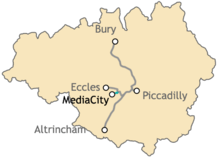
Costs for Phase 3 implementation were revised in the December after the 2002 Commonwealth Games, totalling £820,000,000 (£1,203,000,000 as of 2016),[40] meaning Metrolink required a Government contribution of at least £520,000,000.[52] With costs predicted to rise further, and concerns raised over light rail procurement nationally,[57] on 20 July 2004, Alistair Darling (the Secretary of State for Transport) announced the Government had withdrawn its share of funding Metrolink due to excessive costs.[52][56][58]
In response, highlighting the legal costs and demolition of homes, schools and offices in anticipation of the new lines,[56] the Get Our Metrolink Back on Track (or Back on Track )[59] campaign spearheaded by the Manchester Evening News and Members of Parliament from Greater Manchester was organised to lobby the Department for Transport to fund Phase 3.[60][57][56][61] Following negotiations between central government and GMPTE and AGMA, Phase 3 funding was confirmed by Douglas Alexander on 6 July 2006,[56] albeit with adjustments (such as axing the Wythenshawe Loop)[62] and splitting the project into two stages: Phase 3a, elements of expansion funded by government investment; and Phase 3b, elements requiring an alternative funding source.[59][57] The MPact-Thales consortium, composed of Laing O'Rourke, VolkerRail and the Thales Group, was appointed to design, build and maintain the 20 miles (32 km) of new line plus a new depot at Old Trafford.[38][57] A 0.25-mile (0.40 km) spur off the Eccles Line to the new MediaCityUK development at Salford Quays, funded separately by the Northwest Regional Development Agency (NWRDA), would also fall to Mpact-Thales.[38][57][13]
Phase 3a, Oldham, Rochdale, East Manchester Line

Phase 3a involved converting the 14-mile (23 km) Oldham Loop heavy rail line from Victoria to Rochdale via Oldham, building a new 1.7-mile (2.7 km) South Manchester Line from Trafford Bar to St Werburgh's Road in Chorlton-cum-Hardy (on a closed section of Cheshire Lines Committee railway), and construction of a new 4-mile (6.4 km) East Manchester Line from Piccadilly to Droylsden.[13][15][59][63] The Oldham and Rochdale and South Manchester Lines were funded by a £244,000,000 lump sum from the government.[13][59] The East Manchester Line to Droylsden was funded by borrowings by GMPTE that would be repaid over 30 years using fare revenue from Metrolink.[15]
The Oldham Loop Line closed on 3 October 2009 allowing work to convert the line from heavy rail to Metrolink,[64][65] Conversion of the Oldham Loop for Metrolink allowed for the addition of new stops along the line, including Monsall, South Chadderton, and Newbold;[66] Kingsway Business Park tram stop was authorised at a late stage of planning in July 2011.[67]

Services on the spur from the Eccles Line to MediaCityUK tram stop began on 20 September 2010,[68] serving the MediaCityUK development, and The Lowry arts centre.[57][13][29][69]
The planned opening of Phase 3a services was initially delayed on each line by months due to faults with a new £22,000,000 digital signalling and control system known as the Tram Management System, or TMS, designed by the Thales Group.[70] On its inauguration, TMS experienced several faults on the expanded Eccles Line, causing "chaos" at MediaCityUK, and 24 service delays on the network between September 2010 and February 2011.[70][71]
On the South Manchester Line, services to St Werburgh's Road tram stop commenced on 7 July 2011.[72][63] On the Oldham and Rochdale Line, services from Manchester to Central Park and Oldham Mumps were expected to open in spring 2011 and autumn 2011 respectively,[13][73] but problems with TMS and the need to renew structures delayed services until 13 June 2012, when 7.1 miles (11.4 km) of the line from Victoria to Oldham Mumps tram stop opened in a single stage.[66][74][75] A service on the Oldham and Rochdale Line from Oldham Mumps as far as Shaw and Crompton tram stop began on 16 December 2012.[76][77]
In January 2013, a contract dispute between TfGM and Thales Group over missed deadlines and poor performance of TMS resulted in TfGM withholding payments for unfulfilled construction targets.[70] Services to Rochdale and Droylsden were scheduled for a spring 2012 opening date,[13][78] but delayed by months because of problems with the implementation of TMS, prompting outrage from Members of Parliament representing these areas.[79][80] The East Manchester Line to Droylsden opened to selected residents of Manchester and Tameside on 8 February 2013, and to the general public on 11 February 2013.[79][81] On 28 February 2013, passenger services expanded along the 4.6-mile (7.4 km) stretch of the Oldham and Rochdale Line between Shaw and Crompton and Rochdale railway station, completing Phase 3a, and giving Metrolink a total network length of 43 miles (69 km).[82][83] On 9 May 2013, TMS was successfully implemented in the City Zone, providing real-time passenger information displays at all stops in Manchester city centre.[84]
Phase 3b: Ashton-under-Lyne, East Didsbury and Manchester Airport
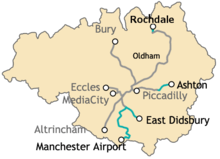
Phase 3b involved extending the East Manchester Line by 2.4 miles (3.9 km) from Droylsden to Ashton-under-Lyne;[85] extending the South Manchester Line by 2.7 miles (4.3 km) from St Werburgh's Road to Didsbury;[86] and creating a new 9-mile (14 km) Airport Line to Manchester Airport from a junction at St Werburgh's Road.[87] Phase 3b also enacted long held plans first drawn up in 1983, to re-route and extend the Oldham and Rochdale Line with a street running route through Oldham and Rochdale town centres, both of which were poorly served by using the outlying Oldham Mumps and Rochdale railway stations alone.[88][89][66][90][91]
Tasked with procuring funds for Phase 3b from sources other than central Government, in July 2007 GMPTE and AGMA submitted a bid to the Transport Innovation Fund, which would release a multimillion-pound sum for public transport improvements linked to viable anti-road traffic congestion strategies.[92][93] A referendum on the Greater Manchester Transport Innovation Fund was held in Greater Manchester on 19 December 2008,[94] in which 79% of voters rejected plans for public transport improvements linked to a peak-time weekday-only Greater Manchester congestion charge.[95] In May 2009, Greater Manchester Integrated Transport Authority (formerly GMPTA) and AGMA agreed to create the Greater Manchester Transport Fund, £1.5billion raised from a combination of a levy on council tax in Greater Manchester, government grants, contributions from the Manchester Airports Group, Metrolink fares and third-party funding for "major transport schemes" in the region.[96][90] Phase 3b was approved with funding on a line-by-line basis between March and August 2010.[85][90]
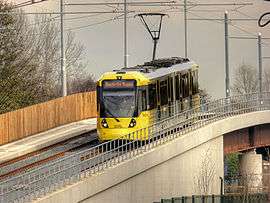
Construction work for all Phase 3b lines began in March 2011.[97] The 2.7-mile (4.3 km) route of the South Manchester Line from St Werburgh's Road to East Didsbury tram stop was the first section of Phase 3b line to open on 23 May 2013 – three months ahead of schedule.[86][98] The East Manchester Line was completed on 9 October 2013 with a new service routed 2.1 miles (3.4 km) between Droylsden and Ashton-under-Lyne tram stop, taking the total system length to 47.7 miles (76.8 km).[99][100][101] The Oldham and Rochdale Line was completed with a street-running service through Oldham Town Centre on 27 January 2014,[102] and the addition of a street-running service between Rochdale railway station and Rochdale Town Centre on 31 March 2014, taking the total system length to 48.5 miles (78.1 km).[11]
On 3 November 2014, the network once again expanded, with a 14.5-mile (23.3 km) extension to Manchester Airport railway station, bringing the length of the system to 92.5 kilometres (57.5 mi), making it the longest tramway in the United Kingdom, and the longest light railway.[103] It opened more than one year early,[104] and at a cost of £368 million.[105]
Current works and confirmed expansion plans
Phase 2CC

The Second City Crossing (also known as 2CC)[106] is a second Metrolink route across Manchester city centre, first proposed in 2011 as a means to improve capacity, flexibility and reliability as the rest of the system expands due to phases 3a and 3b.[9][106][107][13][108] Funded by the Greater Manchester Transport Fund, its 0.8-mile (1.3 km) route will begin at a rebuilt St Peter's Square tram stop, and run along Princess Street, Cross Street and Corporation Street to rejoin the existing Metrolink line by Victoria station.[107][109] Following the submission of a planning document under the Transport and Works Act 1992, and a public inquiry held throughout 2013,[109][110] the Second City Crossing was granted approval on 8 October 2013 by the Secretary of State for Transport, Patrick McLoughlin,[108][111] and signed off on 28 October 2013 by the Greater Manchester Combined Authority.[112] Construction started in early 2014 with Exchange Square tram stop and the first tracks of the line were laid in late November 2014.[106][111][112] Exchange Square joined the network as a new stop on the crossing in December 2015, meaning a Shaw and Crompton-to-Exchange Square service could begin. Completion of the whole line is expected in 2016/17.
Trafford Park Extension
The Transport & Works Act Order for the Trafford Park Line was granted in October 2016.[113][114][115]
Operator

Metrolink is owned by TfGM and operated and maintained by private transport firms under an operating and maintenance (O&M) contract. Between 1992 and 1997 Metrolink was operated and maintained as a concession by Greater Manchester Metro Limited, between 1997 and 2007 by Serco.[116] From 2007 until 2011 it was operated and maintained by Stagecoach Metrolink – part of the Stagecoach Group.[117][118] Metrolink RATP Dev, a part of the French state-owned RATP Group which operates the Paris Métro, bought the Metrolink contract from Stagecoach on 1 August 2011.[9][10][119]
In October 2015, TfGM announced RATP Group, Keolis/Amey, National Express and Transdev had been shortlisted to bid for the next contract starting in July 2017.[120]
Metrolink has been headed by Peter Cushing since February 2013.[121]
Branding and public relations
The name Metrolink and a system-wide aquamarine, black and grey corporate branding and vehicle livery was devised by Fitch RS and Design Triangle,[122][123] and first revealed at a press launch in June 1988.[124][125] Previously, during the planning and promotional stages, the system was known as Project Light Rail, and borrowed an orange and brown identity used by Greater Manchester Transport and GM Buses.[126][127] In August 1991, in partnership with BBC Manchester, Metrolink ran a "Nickname Metrolink" competition to find an affectionate short name for the system, comparable to "The Tube" for London Underground and "The L" for the Chicago elevated transit system. Most submissions were inspired by textile manufacturing, Greater Manchester's historic staple industry, using names such as "The Thread" and "The Shuttle", but the winning entry was "The Met".[127] In 2008, a distinctive yellow and metallic silver vehicle livery, and corresponding yellow system-wide corporate re-branding was introduced by Manchester-based Hemisphere Design and Marketing Consultancy, designed in partnership with Peter Saville, Dalton Maag and Design Triangle.[38][128] Yellow was chosen by Hemisphere for its high visibility and to reflect Greater Manchester's culture of confidence and optimism.[129]
Metrolink has been a "Football Development Partner" with the Manchester Football Association since August 2010,[130] meaning it is the association's Official Travel Partner, and supports grassroots association football in Greater Manchester by selecting a "Team of the Month".[131] Metrolink is a sponsor of the annual Manchester Food and Drink Festival.[132] On 6 December 2010, to celebrate the soap opera's 50th anniversary, Coronation Street featured a storyline with an explosion which caused a crash on the Metrolink system at Weatherfield.[133] Although a fictitious event, at least six calls were made to GMPTE asking if services had been affected.[134]
Transport planners in Greater Manchester describe Metrolink as both "an icon of Greater Manchester",[135] and "an integral part of the landscape in Greater Manchester".[60] The Guardian describes Metrolink as "Manchester's efficient and much-loved tram system".[52] Under ownership of the Guardian Media Group, the Manchester Evening News spearheaded the Get Our Metrolink Back on Track campaign in 2004–05.[61] Under Trinity Mirror ownership, the Manchester Evening News used the Freedom of Information Act 2000 to reveal that Metrolink received over 10,000 complaints between May 2011 and May 2012.[136]
In 2013, then Manchester City F.C. manager Roberto Mancini and players Joe Hart, Vincent Kompany and James Milner recorded special stop announcements to be used on Metrolink's East Manchester Line on dates when Manchester City play at home at the City of Manchester Stadium (served by the Etihad Campus tram stop). The announcements were first used on 17 February 2013, for Manchester City's FA Cup Fifth Round tie against Leeds United A.F.C..[137][138]
Infrastructure
Stops and lines

As of December 2015, Metrolink has a network length of 57 miles (92 km) and 93 stops[139] — along seven lines which radiate from a "central triangular junction at Piccadilly Gardens which forms the hub of the Metrolink system" in the City Zone.[140] The lines are: the Airport Line (which terminates at Manchester Airport), the Altrincham Line (which terminates in Altrincham), the Bury Line (which terminates in Bury), the East Manchester Line (which terminates in Ashton-under-Lyne), the South Manchester Line (which terminates in East Didsbury), the Eccles Line (which terminates in Eccles), and the Oldham and Rochdale Line (which terminates in Rochdale).[141] Some stops, such as Cornbrook, are shared between lines, and may be used as interchange stations;[141] others, such as Altrincham Interchange, are transport hubs which integrate with heavy rail and bus stations.[141] Each stop has at least one high-floor platform measuring a minimum of 2 metres (6.6 ft) wide, accessed by ramp, stairs, escalator, lift or combination thereof.[9][142] Low-floor platforms commonly used for light rail throughout the world were ruled out for Metrolink because the system inherited 90-centimetre (35 in) high-floor platforms from British Rail on lines formerly used for heavy rail.[143] Shelters and canopies at stops were supplied by JCDecaux,[142] and ticket vending machines by Scheidt & Bachmann.[144] Card readers are installed on all stop platforms, ready for the TfGM 'My Get Me There' smart card being trialled in 2014; and when this is fully implemented all smart card users will touch-in and touch-out at a platform reader. Each line has track with standard gauge specification, powering vehicles electrically from 750 V DC overhead lines.[145] Between 1992 and 2007, electricity for the Metrolink system was procured by the operator, based on price only.[3] In 2007, GMPTE changed the contractual requirements to ensure that sustainable power would be factored into choosing an energy supplier, and in July 2007, Metrolink became the first light rail network in the UK with electricity supplied entirely from sustainable energy via hydropower.[3] Now, energy for the system is generated by biomass.[146]
| Line or zone | First operated |
Route type(s) | Length | Number of Stations |
Peak frequency[147] | Start | Terminus | |||
|---|---|---|---|---|---|---|---|---|---|---|
| Current | ||||||||||
| Airport Line | 3 November 2014 | On and off-street[lower-alpha 1] | 23.2 km 14.5 mi[32] |
15 | 12 minute | Barlow Moor Road | Manchester Airport | |||
| Altrincham Line | 15 June 1992 | Converted railway track | 12.2 km 7.6 mi[32] |
10 | 6 minute (less before Trafford Bar) |
Cornbrook | Altrincham | |||
| Bury Line | 6 April 1992 | Converted railway track | 15.9 km 9.9 mi |
10 | 6 minute | Queens Road | Bury | |||
| City Zone | 4 June 2011 | On and off-street | 9 | Various | Victoria | Deansgate-Castlefield or New Islington | ||||
| East Manchester Line | 11 February 2013 | On and off-street | 9.7 km 6 mi[148] |
11 | 12 minute (6 minute before Etihad Campus) |
Holt Town | Ashton-under-Lyne | |||
| Eccles Line | 6 December 1998 | On and off-street | 6.4 km 4 mi[149] |
10 | 12 minute (6 minute before Harbour City) |
Pomona | Eccles | |||
| MediaCityUK spur[lower-alpha 2] | 3 September 2010 | Off-street | 0.3 km 0.2 mi |
1 | 12 minute | – | MediaCityUK | |||
| Oldham and Rochdale Line | 13 June 2012 | Converted railway track | 23.8 km 14.8 mi[11] |
19 | 12 minute (6 minute before Shaw and Crompton) |
Monsall | Rochdale | |||
| South Manchester Line | 7 July 2011 | Converted railway bed | 7.1 km 4.4 mi[135] |
8 | 6 minute (4 minute before St Werburgh's Road) |
Firswood | East Didsbury | |||
| Future | ||||||||||
| Trafford Park Line | 2019–20[lower-alpha 3] | 5.5 km 3.4 mi |
6 | Wharfside | Trafford Centre | |||||
| ||||||||||
Depots
Metrolink House at Queens Road in Cheetham Hill is the headquarters of Metrolink.[150] Constructed during Phase 1, it served jointly as a control centre, HQ, office space, and depot for the storage, maintenance and repair of vehicles.[150] Under the original proposals, Metrolink House was much larger, with a design which would support network expansion, but this design did not obtain the necessary planning permission from Manchester City Council.[150] Consequently, Metrolink House was scaled down to a 4-hectare (9.9-acre) £8,000,000 site with limited capacity,[150][151] and, in light of Phase 3a network expansion, Metrolink built a second depot at Elsinore Road in Old Trafford in 2011.[152][135] This second depot occupies the site of a former warehouse, and can house up to 96 vehicles.[135] On 7 May 2013 Metrolink completed the transfer of its main operational functions from Cheetham Hill to Old Trafford, meaning its control room – known as the Network Management Centre – is housed jointly with the Customer Services team by its newer depot.[153]
Wi-Fi
In July 2013, the Transport for Greater Manchester Committee announced that it planned to enhance the experience of travelling on Metrolink by tapping in to Manchester City Council's grant from the UK Urban Broadband Fund and using it to provide Metrolink passengers with free Wi-Fi when on board. The scheme began with a trial on a single tram – number 3054 – connected to the FreeBeeMcr broadband network with the intention of rolling it out across the whole Metrolink network by Spring 2015.[154][155] It was rolled out fleet wide in March 2015.[156]
Proposed changes and expansion
Buckley Wells
Buckley Wells tram stop has been proposed to provide better passenger access in southern Bury, and would be on the Bury Line between Bury Interchange and Radcliffe tram stop.[13]
Middleton extension
As of 2013, Rochdale Metropolitan Borough Council aspires to link Middleton to the Metrolink network by constructing a branch off the Bury Line routed from Bowker Vale tram stop to Middleton town centre.[157] Rochdale Council first proposed this extension of Metrolink to Middleton in 2008, and priced the scheme at £80,000,000.[158]
Oldham extension
In January 2016, Jim McMahon, MP for Oldham West and Royton, proposed two loop extensions to the metrolink system around Oldham. The link would add a spur from Westwood tram stop to Middleton town centre, before joining the Bury line near Bowker Vale, in line with the proposed Middleton extension.
The Ashton Loop would extend the line beyond Ashton town centre to Oldham Mumps. Both would connect Rochdale to its neighbouring towns without the need to travel in and out of Manchester city centre. Initial high level feasibility work was undertaken by officials at Transport for Greater Manchester which demonstrated the route is technically possible.[159]
Salford expansion
In Salford City Council's 2004–2016 unitary development plan:
- Extending from Eccles Interchange along the A57 road to Barton-upon-Irwell and then across the Manchester Ship Canal to the Trafford Centre.[160]
- Re-opening the Tyldesley Loopline from Eccles to Little Hulton via Walkden with Metrolink services.[160]
- Tram-train between Manchester and Wigan via Salford, as proposed by the Regional Spatial Strategy for North West England.[160]
Stalybridge extension
As of 2011, Tameside Metropolitan Borough Council aspires to extend the East Manchester Line from Ashton-under-Lyne to Stalybridge.[161]
Stockport tram-train strategy
In January 2015 Stockport Metropolitan Borough adopted a Rail Strategy proposing substantial conversion of current rail alignments around Stockport to tram-train operation, running into an interchange at Stockport bus station. These proposed services expand on, and are consistent with, those outlined in the TfGM tram-train strategy document. Earlier plans (now discarded) had envisaged the Metrolink line to East Didsbury being extended to Stockport along the Mersey Valley. The revised plan proposes instead a revised alignment for this link via Edgeley and Stockport railway station.
- Stockport town centre to Manchester city centre via Heaton Norris, Reddish South and Belle Vue (linking with the proposed Manchester – Marple tram-train line);
- Stockport town centre to Manchester Airport via Edgeley and Baguley;
- Stockport town centre to Altrincham via Edgeley and Baguley;
- Stockport town centre to East Didsbury (and on to Manchester city centre), via Edgeley and Gorsey Bank;
- Hazel Grove to East Didsbury via Gorsey Bank.
In the Rail Strategy, Stockport MBC also outline longer term aspirations to establish tram-train services between Stockport town centre and Marple; and between Stockport town centre and Ashton town centre.[162]
Trafford Park line
TfGM holds powers to commission a new line from Pomona to Port Salford via Trafford Park and the Trafford Centre,[29] and committed to procuring a funding mechanism for its construction in 2011.[55][163] Drawing on proposals made by Trafford Metropolitan Borough Council in 1984,[164] TfGM made this a strategic priority in each of its local transport plans since the Transport Act 2000, attesting that Metrolink provision will improve public access to key attractions, support the development of business and freight zones, and reduce traffic congestion on the M60 motorway.[163] In 2004, Peel Holdings raised concerns that the lack of Metrolink provision to the Trafford Centre may impact on its Chill Factore development, and offered to contribute towards its cost.[9][165] In summer 2013, the Greater Manchester Combined Authority and the Greater Manchester Local Enterprise Partnership announced it may fund the construction of the line as far as a stop at the Trafford Centre using the Earnback mechanism of the Greater Manchester City Deal;[166] with an extension to Port Salford and Eccles to be developed and costed separately.[112][167] TfGM estimated that it would require £350,000,000 to open this route to passengers by its target of 2018/19 (subject to a satisfactory business case, Transport and Works Act Order and public consultation).[167] In November 2014, the UK Treasury confirmed earnback funding for the Trafford Park Line as part of the devolution deal for the Greater Manchester Combined Authority.[168]
Tram-trains
Metrolink and the TfGM Committee have prepared five costed proposals for extending Metrolink using tram-train technology over the existing heavy rail network in the region; along the Mid-Cheshire Line (between Stockport and Hale), the Hope Valley Line (between Manchester and Marple), the Glossop Line (between Manchester and the dual termini at Hadfield and Glossop), the Manchester to Sheffield Line (between Manchester and Hazel Grove), and along the Manchester to Southport Line (between Manchester and Wigan via Atherton), with an estimated total funding requirement of £870 million as of 2013.[169] TfGM intend to proceed to the identification of potential rail industry funding options, subject to a review of lessons from a tram-train pilot scheme in Sheffield.[170]
Wythenshawe Loop
Although axed in 2005 to control costs, the Wythenshawe Loop on the Airport Line remains an aspiration of TfGM.[57] As of October 2014 there is renewed interest from TFGM, particularly as the route could link with HS2 Manchester Interchange.[171] It would create a loop from Roundthorn tram stop to the University Hospital of South Manchester (Wythenshawe Hospital) and Newall Green and back to Roundthorn, and improve access between Wythenshawe and Manchester city centre on a route which is physically impaired by the River Mersey and M60 motorway.[13][15]
Rolling stock
Metrolink is operated by fleet of 120 M5000 trams, which were first introduced in 2009, and continued to be delivered until 2016. These replaced the former fleet of thirty-two T-68 and T-68A trams, which had operated the network since opening in 1992, these were withdrawn from service during 2012–14.[172]
Because low-floor tram technology was in its infancy when Metrolink was in its planning stages, and in order to be compatible with the former British Rail stations Metrolink inherited, the network uses high-floor trams with a platform height of 900 mm (35 in).[172][13]
_(cropped).jpg)
M5000
In December 2009, Metrolink took delivery of the first M5000 tram. Built by Bombardier Transportation and Vossloh Kiepe, the initial eight M5000s were ordered to allow services to be increased.[13] They are part of the Flexity Swift range of light rail vehicles, and have a design similar to the K5000 vehicle used on the Cologne Stadtbahn.[13][15][46][173][174]
With the approval of the spur to MediaCityUK, a further four were ordered.[13] To provide rolling stock for the phase 3 extensions and replace the existing fleet, the order was increased successively to 94.[46][175][176][177] In December 2013, a further ten M5000s were ordered to provide trams for the Trafford Park Line planned to open in 2020, while in the interim supporting a service between MediaCityUK and Manchester city centre and other capacity enhancements.[112][178] In September 2014, a further 16 were ordered, this will bring the fleet up to 120.[179][180][181]
| Class | Image | Type | Top speed | Number | Fleet Numbers | Routes operated | Built | Years operated | |
|---|---|---|---|---|---|---|---|---|---|
| mph | km/h | ||||||||
| M5000 | Tram | 50 | 80 | 120 | 3001–3120 | All lines | 2009–2016 | 2009–present | |
Ancillary vehicles
Metrolink has one Special Purpose Vehicle from 1991. Numbered 1027 with its support wagon 1028, it is a bespoke diesel-powered vehicle with a crane, inspection platform, mobile workshop, and capacity for a driver and three passengers. It was designed to assist with vehicle recovery and track and line repairs.[182]
Former fleet
T-68/68A

To commence operations, a fleet of 26 T-68 trams manufactured by AnsaldoBreda in Italy were delivered in 1992.[183][184] To provide extra trams for the Eccles Line, six modified T-68A trams were purchased in 1999.[13] The T-68A vehicles were based on the original T-68s, but had modifications replacing destination rollblinds with dot matrix displays, and retractable couplers and covered bogies necessary for the high proportion of on-street running close to motor traffic.[13]
Three of the earlier T-68 fleet were similarly equipped,[13] and were known as T-68Ms.[185] Mechanically and electrically the T-68M vehicles remained essentially a T-68, but had modifications to its brakes, mirrors, and speed limiters to suit the Eccles line.[185] Initially only these vehicles were permitted to operate the Eccles line but the entire fleet except for 3 (1018, 1019, 1020) were modified between 2008 and 2012 for universal running,[13] under a programme known as the T-68X Universal Running programme.[186]
The newer M5000 trams proved to be considerably more reliable than the T-68/A fleet; which averaged 5,000 miles between breakdowns, while the M5000's average 20,000 miles. This led to a decision in 2012 to withdraw the entire fleet from service and replace them with M5000's. All of the T-68 and T-68As were withdrawn between April 2012 and April 2014.[187]
Tram no. 1007, the first to pass through the City Centre on the opening day, is due to be restored into Heaton Park Tramway,[188] and is believed to be the only T-68 to be kept from scrapping.
| Class | Image | Type | Top speed | Number | Fleet Numbers | Routes operated | Built | Years operated | |
|---|---|---|---|---|---|---|---|---|---|
| mph | km/h | ||||||||
| T-68 |  |
Tram | 50 | 80 | 26 | 1001–1026 | Bury-Altrincham-Piccadilly (later Eccles) |
1991–1992 | 1992–2014 |
| T-68A | 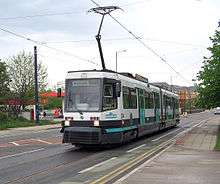 |
Tram | 50 | 80 | 6 | 2001–2006 | Eccles Line | 1999 | 1999–2014 |
Travelling
Service patterns

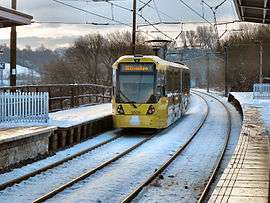
Before inauguration, GMPTE's original concept was for Metrolink's operator to provide a service every ten minutes from Bury-to-Piccadilly and Altrincham-to-Piccadilly 6 a.m.–Midnight, Monday to Saturday.[189] Greater Manchester Metro Limited, the system's original operator, argued for adjustments, citing the need to provide an efficient and commercially viable operation in line with vehicle running times and passenger demand.[189] Due to power limitations, this pattern was modified to a twelve-minute service throughout the day, doubling to a six-minute service in peak periods, resulting in a "ten trams per hour" service pattern on routes running from Altrincham and Bury to Manchester every six minutes.[189] Operators are required to provide this level of service at least 98% of the time, or incur a financial penalty charge.[190] This six-minute service pattern has been adopted on the rest of the network as the system has grown.[82][191][192] Heavy snowfall during the winter of 2009/10 impaired Metrolink services and the operator was criticised for failing to have cold weather procedures.[119] This prompted a programme to improve reliability and performance of the system in freezing conditions.[119][193] Metrolink operated icebreaker-style vehicles at night during snowfall in January 2013 to provide normal services.[194]
In January 2016, Transport for General Manchester agreed a baseline Service Specification to grade bidders seeking to operate the concession from July 2017; once the Second City Crossing is in operation. In the baseline service pattern, there are no designated 'peak' periods of service operation; instead there will be an 'enhanced' service operating from start of service to 8pm Monday to Friday, and to 6pm Saturday; and a 'core' service running at all other times. In the 'enhanced' service pattern, trams will run with a 6-minute frequency to Shaw & Oldham, Bury, Ashton, Altrincham, Manchester Airport and East Didsbury; and with a 12-minute frequency to Rochdale, Eccles and MediacityUK. When the Trafford line opens, services will run to the Trafford Centre with a 12-minute frequency. In the 'core' service pattern, all lines will run with a 12-minute frequency.[195]
Tram services
Peak time service:[196]
Peak time is 07:15–19:30 on weekdays and 09:30–18:30 on Saturdays.
Nine services which all run every 12 minutes:
- (A) Altrincham – Bury
- (B) Altrincham – Piccadilly
- (D) MediaCityUK – Piccadilly
- (E) Eccles – Ashton-under-Lyne via MediaCityUK
- (F) Manchester Airport – Cornbrook
- (G) Bury – Etihad Campus
- (H) Shaw & Crompton – East Didsbury
- (I) Rochdale Town Centre – Exchange Square
- (K) East Didsbury – Deansgate-Castlefield
Thus the combined frequency for some routes is at least every 6 minutes if not greater.
Offpeak service:[196]
Offpeak is before 07:15 and after 19:30 on weekdays, before 09:30 and after 18:30 on Saturdays, and all day Sundays and bank holidays.
Six services which all run every 12 minutes:
- (B) Altrincham – Piccadilly
- (C) East Didsbury – Victoria
- (E) Eccles – Ashton-under-Lyne via MediaCityUK
- (F) Manchester Airport – Cornbrook
- (G) Bury – Etihad Campus
- (I) Rochdale Town Centre – Exchange Square
Early morning service:[196]
The early morning service operates 03:00–06:00 Monday to Saturday and 03:00–07:00 on Sundays and bank holidays.
One service which runs every 20 minutes:
- (J) Firswood – Manchester Airport
This is largely to support airport shift workers and people with early flights.
| Metrolink service routes[141] | ||
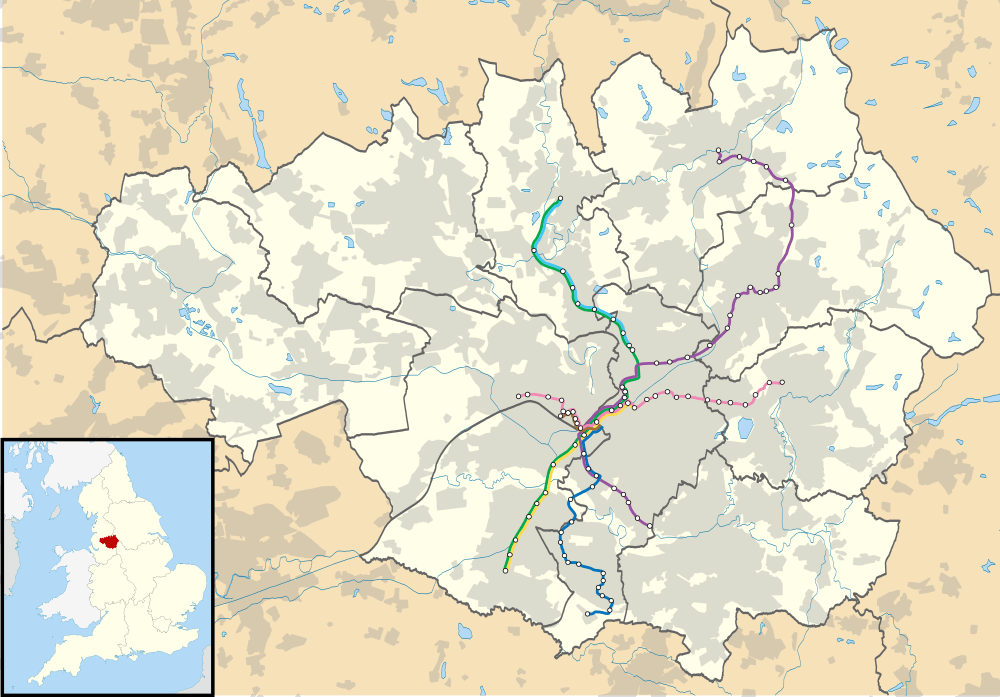
| ||
| (A) Altrincham – Bury (peak only) |
(B) Altrincham – Piccadilly | (C) East Didsbury – Victoria (offpeak only) |
|---|---|---|
|
||
| (D) MediaCityUK – Piccadilly (peak only) |
(E) Eccles – Ashton-under-Lyne (via MediaCityUK) |
(F) Manchester Airport – Cornbrook |
|
||
| (G) Bury – Etihad Campus | (H) Shaw and Crompton – East Didsbury (peak only) |
(I) Rochdale Town Centre – Exchange Square |
|
||
| (J) Firswood – Manchester Airport (03:00–06:00 only) |
(K) East Didsbury – Deansgate-Castlefield (peak only) | |
Ticketing
Metrolink fares were originally set by the system's operator,[189] but are now set by the TfGM Committee at levels that cover both the running costs and the cost of borrowing that has part-funded the expansion of the system;[197] Metrolink receives no public subsidy.[198][199] Fares typically rise each January above the rate of inflation.[200][201] The fare tariff is based on a division of the network's stations into fare zones.[202] Persons under 16 years of age, persons of pensionable age, and people with disabilities qualify for concessionary fares, some of which are mandatory and others discretionary, as determined by the Greater Manchester Combined Authority.[197] The Greater Manchester Combined Authority permits reduced fares for persons under 16 years of age, and free or reduced fares on Metrolink after 9:30 a.m. for pensioners.[197] In normal circumstances, tickets cannot be purchased on board Metrolink vehicles, and must be purchased from a ticket vending machine before boarding the vehicle.[203] Fare evasion in 2006 was estimated at 2–6% of all users,[204] and in 2012 at 2.5% of all users.[205] Checking tickets and passes and issuing Standard fares is the responsibility of Metrolink's Passenger Services Representatives (PSRs), who provide security and assistance on the network;[206][205] between 1992 and 2008, Greater Manchester Police had a dedicated Metrolink unit responsible for policing the system.[207] The original ticket vending machines were designed by Thorn EMI.[202] In 2005 GMPTE announced that rail passengers travelling from within Greater Manchester into Manchester city centre can use the Metrolink service between the eight City Zone stations for free.[208] Passengers must present a valid rail ticket, correctly dated with Manchester Ctlz as the destination.[209][210] In 2007 TfGM rolled out new ticket vending machines, designed to accept credit/debit card payments and permit the purchase of multiple tickets in a single transaction.[211] These were replaced in 2009 with touchscreen machines, designed with the Scheidt & Bachmann Ticket XPress system.[144] In October 2012, TfGM announced it was devising a simpler zonal fare system, comparable to London fare zones, and preparing to introduce get me there, the region's new contactless smartcard system, for use on all public transport modes in Greater Manchester, including Metrolink.[200]
Passenger numbers
The Department for Transport reported passenger journeys for the 2015/16 financial year at 34.3 million; a 10.1% increase from 31.2 million the previous year.[4] Patronage has risen steadily since its opening, from a start-point of 8.1 million in the 1992/93 fiscal year.[48] Travel increased from 18.2 million journeys in 2001/02 to 20 million journeys in 2008/09; numbers fell to 18.7 million in 2009 while parts of the system were closed for upgrades, but recovered[212] to 19.6 million for the 2009/10 fiscal year.[48] Metrolink revised its method for calculating passenger boardings in 2010/11, meaning figures are not directly comparable with previous years.[48] TfGM projects that 41.7 million passenger journeys per year will be made on the Metrolink system by 2016/17.[16]
| Estimated passenger journeys made on Metrolink per financial year | |||||||||||
|---|---|---|---|---|---|---|---|---|---|---|---|
| Year | Passenger journeys | Year | Passenger journeys | Year | Passenger journeys | Year | Passenger journeys | ||||
| 1992/93 | 8.1m | 1999/00 | 14.2m | 2006/07 | 19.8m | 2013/14 | 29.2m | ||||
| 1993/94 | 11.3m | 2000/01 | 17.2m | 2007/08 | 20.0m | 2014/15 | 31.2m | ||||
| 1994/95 | 12.3m | 2001/02 | 18.2m | 2008/09 | 21.1m | 2015/16 | 34.3m | ||||
| 1995/96 | 12.6m | 2002/03 | 18.8m | 2009/10 | 19.6m | ||||||
| 1996/97 | 13.4m | 2003/04 | 18.9m | 2010/11 | 19.2m | ||||||
| 1997/98 | 13.8m | 2004/05 | 19.7m | 2011/12 | 21.8m | ||||||
| 1998/99 | 13.2m | 2005/06 | 19.9m | 2012/13 | 25.0m | ||||||
| Estimates provided by TfGM to the Department for Transport,[4] based on sales from ticket machines.[note 2] | |||||||||||

A survey in 2012 revealed that 12%, or around one in 10 people in Greater Manchester use Metrolink to travel to work, and 8% use the system every day.[198] The system is most commonly used by 21- to 30-year olds, and was used most markedly by residents of the Metropolitan Borough of Bury — accounting for around a third of their commuter journeys.[198]
Passenger satisfaction
A survey in 2012 revealed that passengers who used Metrolink everyday for commuting rated service levels as poor and/or unreliable, with those respondents particularly frustrated by delays and disruptions.[198] TfGM recognised that the older vehicles in its fleet – the T68/T68As — were outdated and the cause of much disruption, and agreed to replace them with M5000s by 2014.[46][175] Among those who used Metrolink less regularly, the system scored far better in the survey.[198] A survey in 2014 by the non-departmental government body Passenger Focus found that of the five major light rail systems in the United Kingdom – Metrolink, Sheffield Supertram, NET, Midland Metro and Blackpool tramway – Metrolink had the lowest overall satisfaction rating in the United Kingdom. Respondents were surveyed on value for money, punctuality, seating availability, tram stations and overall satisfaction. Metrolink was below average on all criteria, and 47% believed Metrolink was value for money compared to a national average of 60%.[214]
Incidents
Unlike some Metro systems in the United Kingdom, the Manchester Metrolink has a high degree of street interaction between pedestrians and motorists with on-street running trams – this is most notable in Manchester city centre. All trams are equipped with a standard horn and a warning horn.[215] A number of fatal incidents have occurred on the network since opening in 1992:
- On 18 October 2002, a pedestrian died after a collision with a tram after falling onto tram tracks near Manchester Central.[216]
- On 25 June 2005, a pedestrian died after a collision with a tram at Navigation Road stop.[217]
- On 5 June 2011, a pedestrian died after a collision near Piccadilly Gardens.[218]
- On 15 December 2011, a blind man died after a collision with a tram near St Peters' Square.
- On 6 February 2013, a pedestrian died after a collision with a tram at the Failsworth stop.[219]
- On 11 January 2014, a pedestrian died after a collision with a tram at the Market Street stop.[220]
- On 16 February 2016, a cyclist died after a collision with a tram at the Robinswood Road stop.[221]
See also
| Part of a series of articles on |
| Metrolink |
|---|
 |
- List of tram and light-rail transit systems
- Manchester Corporation Tramways
- Transport in Manchester
- List of town tramway systems in England
- List of town tramway systems in the United Kingdom
Notes
- ↑ The system is branded Metrolink.[1][2][3] The Department for Transport refers to the system as Manchester Metrolink,[4] an alternative unofficial name.[5][6] It is defined in Acts of Parliament and Byelaws as the Greater Manchester Light Rapid Transit System;[2][3] and sometimes (unofficially) called Greater Manchester Metrolink.[7]
- ↑ Estimates excludes free travel such as Concessionary Bus Pass for pensioners and tickets sold through other vendors.[48]
References
- 1 2 Ogden & Senior 1992, p. 4.
- 1 2 Department for Transport (2009). "Explanatory Memorandum to the Greater Manchester (Light Rapid Transit System) (Exemptions) Order 2009". legislation.gov.uk. Retrieved 19 January 2013.
The Order grants exemptions from certain requirements of railways legislation currently applying to the Greater Manchester Light Rapid Transit System ("Metrolink") ...
- 1 2 3 4 Slatcher, Adrian (17 December 2010). "Procurement of hydro-electricity for Metrolink – the Greater Manchester light rapid transit system.". Manchester: Energy Planning Knowledge Base. Retrieved 19 January 2013.
GMPTE own the Greater Manchester light rapid transit system – known as Metrolink.
- 1 2 3 4 "Light Rail and Tram Statistics: England 2015/16" (PDF). Department for Transport. 7 June 2016. Retrieved 8 June 2016.
- ↑ Ogden & Senior 1992, p. 106.
- 1 2 "£500m tram extension unveiled". BBC News. 22 March 2000. Retrieved 5 January 2013.
- ↑ Ogden & Senior 1992, p. 39.
- ↑ "LTRA World Systems List index". lrta.org. Light Rail Transit Association. Retrieved 11 December 2014.
- 1 2 3 4 5 6 "Salford Infrastructure Delivery Plan" (PDF). Salford City Council. February 2012. Retrieved 22 January 2013.
- 1 2 "RATP buys Manchester Metrolink operator". Railway Gazette International. London. 2 August 2011.
- 1 2 3 Scheerhout, John (31 March 2014). "Passenger trams start running to and from Rochdale town centre for first time in 80 years". Manchester Evening News. Retrieved 31 March 2014.
- ↑ "New Metrolink line to Wythenshawe and Manchester Airport to open on November 3 – a year ahead of schedule". Manchester Evening News. 13 October 2014. Retrieved 2 November 2014.
- 1 2 3 4 5 6 7 8 9 10 11 12 13 14 15 16 17 18 19 "Manchester Metrolink, United Kingdom". railway-technology.com. Retrieved 10 January 2013.
- ↑ "Manchester Metrolink, United Kingdom". Railway Technology. 2010. Retrieved 12 July 2013.
- 1 2 3 4 5 6 Kingsley, Nick (19 October 2007). "Manchester plays catch-up with Metrolink expansion". Railway Gazette International. London. Retrieved 12 January 2013.
- 1 2 Transport for Greater Manchester (March 2014). "Greater Manchester Growth and Reform Plan: Transport Strategy and Investment Plan" (PDF). Retrieved 17 August 2014.
- ↑ Wordsworth, Nigel (14 October 2016). "Manchester Metrolink Trafford Park extension approved". Global Rail News. Retrieved 24 October 2016.
- ↑ Museum of Transport Greater Manchester, A Short History of Public Transport in Greater Manchester
- ↑ Holt 1992, p. 4.
- ↑ Ogden & Senior 1992, p. 21.
- 1 2 3 4 5 Ogden & Senior 1992, p. 22.
- 1 2 "Manchester unearths forgotten 1970s tube line". The Architects' Journal. London. 13 March 2012.
- 1 2 Holt 1992, p. 5.
- ↑ Donald, Cross & Bristow 1983, p. 45.
- ↑ Holt 1992, pp. 6–7.
- ↑ Ogden & Senior 1992, pp. 26–27.
- ↑ Ogden & Senior 1992, p. 25.
- ↑ Ogden & Senior 1992, p. 37.
- 1 2 3 4 5 6 7 8 9 10 GMPTE 2000.
- ↑ Ogden & Senior 1992, p. 74.
- 1 2 Ogden & Senior 1991, p. 17.
- 1 2 3 Ogden & Senior 1992, p. 73.
- ↑ Ogden & Senior 1992, p. 56.
- ↑ Ogden & Senior 1991, pp. 14–15.
- ↑ Ogden & Senior 1992, pp. 30–31.
- ↑ Ogden & Senior 1992, p. 51.
- 1 2 Ogden & Senior 1992, p. 47.
- 1 2 3 4 5 6 7 8 9 10 Kessell, Clive (30 November 2011). "Manchester Metrolink 20 Years of Evolution". The Rail Engineer. Retrieved 2 January 2013.
- ↑ Holt 1992, p. 94.
- 1 2 3 4 UK CPI inflation numbers based on data available from Gregory Clark (2016), "The Annual RPI and Average Earnings for Britain, 1209 to Present (New Series)" MeasuringWorth.
- ↑ Ogden & Senior 1991, p. 53.
- ↑ Holt 1992, p. 87.
- ↑ Ogden & Senior 1992, p. 82.
- 1 2 3 4 Holt 1992, p. 90.
- 1 2 3 GMPTE 2003, p. 9.
- 1 2 3 4 "Manchester's oldest Metrolink trams to be replaced". BBC News. 17 July 2012. Retrieved 20 January 2013.
- ↑ Ogden & Senior 1992, p. 13.
- 1 2 3 4 5 "Light rail and tram statistics: 2011/12". Department for Transport. 19 July 2012. Light rail and tram statistics 2011/12 and XLS tables (Table LRT0101). Retrieved 18 January 2013.
- 1 2 GMPTE 2003, p. 13.
- ↑ "Salford Quays Milestones: The Story of Salford Quays" (PDF). Salford City Council. 2008. Retrieved 3 January 2013.
- 1 2 3 4 GMPTE 2003, p. 10.
- 1 2 3 4 Ward, David (2 August 2004). "Tram fury rattles ministers". The Guardian. London. Retrieved 5 January 2013.
- ↑ "Whistle-stop Princess takes home hat souvenir". Manchester Evening News. 9 January 2001. Retrieved 8 January 2013.
- ↑ Docherty & Shaw 2011.
- 1 2 "Greater Manchester Local Transport Plan 2" (PDF). Greater Manchester Passenger Transport Authority. March 2006. Retrieved 5 January 2013.
- 1 2 3 4 5 "Metrolink extension is announced". BBC News. 6 July 2006. Retrieved 7 January 2013.
- 1 2 3 4 5 6 7 TfGM & GMCA 2011, p. 80.
- ↑ "Government scraps trams extension". BBC News. 20 July 2004. Retrieved 19 January 2013.
- 1 2 3 4 "Metrolink: back on track?". BBC News. 13 May 2009. Retrieved 19 January 2013.
- 1 2 Satchell, Clarissa (6 September 2004). "Moving plea to save Metrolink". Manchester Evening News. Retrieved 19 January 2013.
- 1 2 "Oldham Metrolink line a huge success with 250,000 passengers in first three months". Manchester Evening News. 15 September 2012. Retrieved 8 January 2013.
- ↑ "Metrolink 'to axe hospital route'". BBC News. 22 June 2005. Retrieved 19 January 2013.
- 1 2 "First line opens under £1·4bn Manchester tram expansion". Railway Gazette International. London. 8 July 2011. Retrieved 19 January 2013.
- ↑ Kirby, Dean (1 October 2009). "Signalman reaches end of line". Manchester Evening News. Retrieved 5 October 2009.
- ↑ "End of era as loop line is replaced". Manchester Evening News. 26 September 2008. Retrieved 5 October 2009.
- 1 2 3 "Metrolink trams reach Oldham Mumps". Railway Gazette International. London. 13 June 2012. Retrieved 13 January 2013.
- ↑ Jones, Chris (27 July 2011). "Kingsway developers to foot the bill for Metrolink tram stop". Manchester Evening News. Retrieved 19 January 2013.
- ↑ "Metrolink trams pull in to MediaCityUK station for first time". Manchester Evening News. 20 September 2010. Retrieved 25 September 2010.
- ↑ Brooks-Pollock, Tom (30 November 2011). "Lowry gallery and theatre is most popular tourist attraction in Greater Manchester". Manchester Evening News. Retrieved 1 December 2011.
- 1 2 3 Kirby, Dean (3 January 2013). "Metrolink tram bosses and signalling firm in court battle that could cost Greater Manchester taxpayers £42m". Manchester Evening News.
- ↑ Kirby, Dean (27 June 2011). "Rush-hour chaos for tram commuters after Metrolink computer breakdown". Manchester Evening News. Retrieved 19 January 2013.
- ↑ "On track at last: Commuters travel on new Metrolink tram service to south Manchester for first time". Manchester Evening News. 7 July 2012.
- ↑ GMPTE 2010, p. 7.
- ↑ "New tram operating system delays Metrolink extension". BBC News. 9 December 2011. Retrieved 19 January 2013.
- ↑ Kirby, Dean (8 June 2012). "Metrolink Oldham line set to open next Wednesday". Manchester Evening News. Retrieved 11 January 2013.
- ↑ Kirby, Dean (12 December 2012). "Shaw and Crompton Metrolink trams start this Sunday". Manchester Evening News. Retrieved 12 December 2012.
- ↑ "Metrolink stations 'to boost two Greater Manchester areas'". BBC News. 16 December 2012. Retrieved 16 December 2012.
- ↑ GMPTE 2010, pp. 4–7.
- 1 2 Kirby, Dean (4 December 2012). "Opening of Metrolink tram service to Droylsden delayed until February 2013". Manchester Evening News. Retrieved 11 January 2013.
- ↑ Kirby, Dean (4 January 2013). "MPs slam delays to new Metrolink lines to Rochdale and Droylsden". Manchester Evening News. Retrieved 19 January 2013.
- ↑ "It's the final countdown" (Press release). Transport for Greater Manchester. 1 February 2013. Retrieved 1 February 2013.
- 1 2 "Next stop: Rochdale!" (Press release). Transport for Greater Manchester. 20 February 2013. Retrieved 20 February 2013.
- ↑ "Next stop: Rochdale!". Rochdale Online. 20 February 2013. Retrieved 20 February 2013.
- ↑ "Real-time tram information for city centre passengers". Transport for Greater Manchester. 9 May 2013. Retrieved 11 July 2013.
- 1 2 "Ashton and Didsbury Metrolink extensions funded". Railway Gazette International. London. 8 March 2010. Retrieved 20 January 2013.
- 1 2 Kirby, Dean (14 May 2013). "Metrolink extension to East Didsbury to open next week- three months early". Manchester Evening News. Retrieved 14 May 2013.
- ↑ "Manchester Metrolink starts Phase 3b". Railway Gazette International. London. 22 March 2011. Retrieved 20 January 2013.
- ↑ Young 2008, p. 163.
- ↑ Holt 1992, pp. 92–93.
- 1 2 3 "Manchester Metrolink Phase 3b confirmed". Railway Gazette International. London. 5 August 2010. Retrieved 19 January 2013.
- ↑ "Bringing Metrolink to Oldham and Rochdale" (PDF). Greater Manchester Passenger Transport Authority. 2000. Retrieved 15 January 2013.
- ↑ Young 2008, p. 160.
- ↑ "The Link" (PDF). Transport for Greater Manchester. 2008. Retrieved 15 January 2013.
- ↑ "Date set for C-charge referendum". BBC News. 29 September 2008. Retrieved 5 January 2010.
- ↑ Sturcke, James (12 December 2008). "Manchester says no to congestion charging". The Guardian. London. Retrieved 12 December 2008.
- ↑ TfGM 2012, p. 14.
- ↑ "Manchester Metrolink starts Phase 3b". Railway Gazette International. London. 22 March 2011. Retrieved 19 January 2013.
- ↑ Kirby, Dean (22 May 2013). "Destination Didsbury – Metrolink trams to start tomorrow, three months early". Manchester Evening News. Retrieved 22 May 2013.
- ↑ "New Metrolink service to Ashton opens" (Press release). Transport for Greater Manchester. 9 October 2013. Retrieved 9 October 2013.
- ↑ Kent-Smith, Emily (9 October 2013). "Metrolink tram service launches from Ashton-under-Lyne... and it's on time". Manchester Evening News. Retrieved 9 October 2013.
- ↑ Britton, Paul (28 September 2013). "Metrolink service to Ashton-under-Lyne to start on October 9". Manchester Evening News. Retrieved 9 October 2013.
- ↑ Flanagan, Emma (27 January 2014). "Landmarks on the new Oldham Metrolink line, and a driver's eye view tour of the route". Manchester Evening News. Retrieved 31 March 2014.
- ↑ "Metrolink – The Airport Line has landed".
- ↑ "BBC News – Metrolink line to Manchester Airport opens a year early". BBC News.
- ↑ Charlotte Cox (20 June 2014). "Video: Manchester airport Metrolink line to open this year – Manchester Evening News". men.
- 1 2 3 "Metrolink second city crossing 'vital' for Manchester". BBC News. 8 June 2011. Retrieved 7 January 2013.
- 1 2 TfGM & GMCA 2011, p. 84.
- 1 2 "Ministers clear way for second city centre Metrolink line". Place North West. 7 October 2013. Retrieved 7 October 2013.
- 1 2 Qureshi, Yakub (23 January 2013). "New city line is 'vital for future of Metrolink'". Manchester Evening News. Retrieved 23 January 2013.
- ↑ Kirby, Dean (22 January 2013). "Cross-city Metrolink idea on the line as tram inquiry launched". Manchester Evening News. Retrieved 23 January 2013.
- 1 2 "Manchester city centre tram route's green light by Government". BBC News. 8 October 2013. Retrieved 8 October 2013.
- 1 2 3 4 Williams, Jennifer (28 October 2013). "Second cross-city tram link gets green light". Manchester Evening News. Retrieved 28 October 2013.
- ↑ "Metrolink line to the Trafford Centre will go ahead despite objections from Coronation Street and Manchester United". Manchester Evening News. 14 October 2016.
- ↑ "Metrolink's Trafford Park £350m Tramline Approved". BBC News. 13 October 2016.
- ↑ "Powers granted for Manchester Metrolink Trafford Park extension". Railway Gazette International (London). 14 October 2016.
- ↑ Kirby, Dean (2 August 2011). "Stagecoach hand over control of Metrolink system to French firm RATP". Manchester Evening News.
- ↑ "Stagecoach signs Manchester Metrolink contract" (Press release). Stagecoach Group. 29 May 2007. Retrieved 28 December 2008.
- ↑ "Stagecoach take over tram service". BBC News. 15 July 2007. Retrieved 1 November 2008.
- 1 2 3 "Metrolink firm slammed over 'unacceptable' service". Manchester Evening News. 8 November 2011. Retrieved 23 January 2013.
- ↑ Manchester Metrolink operations shortlist announced Railway Gazette International 17 October 2015
- ↑ "Peter Cushing to take over as Metrolink boss". Salford Online. 29 January 2013. Retrieved 29 January 2013.
- ↑ Ogden & Senior 1991, p. 42.
- ↑ Ogden & Senior 1992, p. 143.
- ↑ Holt 1992, pp. 26–27.
- ↑ GMPTE 2003, p. 4.
- ↑ Holt 1992, p. 24.
- 1 2 Holt 1992, p. 30.
- ↑ Donohue, Simon (14 October 2008). "Tram design on the right track". Manchester Evening News. Retrieved 19 January 2013.
- ↑ GMPTE 2009, p. 3.
- ↑ "Metrolink". Manchester Football Association. Retrieved 19 January 2013.
- ↑ "Team of the month: Swinton FC". Manchester Evening News. 3 October 2012. Retrieved 19 January 2013.
- ↑ Bainbridge, Pete (17 September 2010). "Metrolink offers travel pass for Food and Drink Festival". Manchester Evening News. Retrieved 19 January 2013.
- ↑ "Coronation Street tram crash pulls in 13m viewers". BBC News. 7 December 2010. Retrieved 23 January 2013.
- ↑ Kirby, Dean (8 December 2010). "Are the trams still running?: 'Confused' viewers called Metrolink to check service after Coronation Street crash". Manchester Evening News. Retrieved 23 January 2013.
- 1 2 3 4 TfGM 2012, p. 23.
- ↑ "10,000 complaints about Metrolink in one year". Manchester Evening News. 16 October 2012. Retrieved 19 January 2013.
- ↑ Leonard, Ian (13 February 2013). "AUDIO: This is your Droylsden service, next stop is zee Etihad Campus". Daily Mail. London. Retrieved 16 February 2013.
- ↑ Keegan, Mike (12 February 2013). "Manchester City are tram-pions as they voice the announcements for new Etihad Metrolink stop". Manchester Evening News. Retrieved 16 February 2013.
- ↑ TfGM & GMCA 2011, pp. 136–137.
- ↑ Ogden & Senior 1992, p. 61.
- 1 2 3 4 "Route Map" (PDF). Transport for Greater Manchester. 2013. Retrieved 22 May 2013.
- 1 2 Ogden & Senior 1992, pp. 89–90.
- ↑ Holt 1992, p. 31.
- 1 2 GMPTE 2009, p. 4.
- ↑ Ogden & Senior 1992, p. 102.
- ↑ "Pages – TfGM Green Facts".
- ↑ "Tram Frequencies". Metrolink. Retrieved 31 August 2016.
- ↑ Kirby, Dean (6 February 2013). "Video: Sneak preview of Metrolink's brand new East Manchester Line to Droylsden". Manchester Evening News. Retrieved 6 February 2013.
- ↑ GMPTE 2003, p. 15.
- 1 2 3 4 Holt 1992, p. 79.
- ↑ Ogden & Senior 1991, p. 43.
- ↑ GMPTE 2010, p. 6.
- ↑ "Metrolink Completes Move To Old Trafford". Manchester Confidential. 7 May 2013. Retrieved 11 May 2013.
- ↑ "Manchester unveils revised Superconnected Cities plans". The Manchester Gazette. 7 July 2013. Retrieved 7 July 2013.
- ↑ "Wi-Fi tram test-trial on track for Metrolink". The Manchester Gazette. 23 August 2013. Retrieved 24 August 2013.
- ↑ http://altrincham.today/2015/03/30/free-wifi-rolled-out-on-all-metrolink-trams/
- ↑ Coyle, Simon (11 July 2013). "Blueprint for town's future puts tram link in frame". Manchester Evening News. Retrieved 5 August 2013.
- ↑ "Tram link plans are put back on track". Manchester Evening News. 6 September 2012. Retrieved 5 August 2013.
- ↑ http://www.oldham-chronicle.co.uk/news-features/8/news-headlines/96391/jims-loop-lines-vision-for-trams | Retrieved 01 February 2016
- 1 2 3 "City of Salford Unitary Development Plan 2004–2016 Saved Policies". Salford City Council. 2004. p. Accessibility. Retrieved 28 March 2013.
- ↑ TfGM & GMCA 2011, p. 85.
- ↑ "Stockport Rail Strategy" (PDF). January 2015. Retrieved 17 February 2015.
- 1 2 TfGM & GMCA 2011, p. 46.
- ↑ Holt 1992, p. 93.
- ↑ Scheerhout, John (18 August 2004). "'Ski tram' frozen out". Manchester Evening News. Retrieved 26 July 2013.
- ↑ "Trams to the Trafford Centre set for go-ahead". Manchester Evening News. 28 June 2013. Retrieved 29 June 2013.
- 1 2 Greater Manchester Combined Authority (26 July 2013). "Report for Resolution: Earnback Model, SEMMMS and Metrolink Trafford Park Extension" (PDF). Association of Greater Manchester Authorities. Retrieved 26 July 2013.
- ↑ "Devolved Powers for Elected Mayor". Manchester Evening News. 3 November 2014. Retrieved 7 November 2014.
- ↑ "DfT Major Transport Scheme Devolution and the Identification of Future Transport Priorities for Greater Manchester" (PDF). Greater Manchester Local Transport Body. 31 May 2013. Retrieved 10 June 2013.
- ↑ "Metrolink bosses consider plans to run trams on train tracks". Manchester Evening News. 29 May 2012. Retrieved 8 June 2013.
- ↑ "BBC News – Wythenshawe 'western loop' Metrolink tram line to be proposed". BBC News.
- 1 2 "T68 and T68a — Metrolink phase 1 and 2". Light Rail Transit Association. Retrieved 22 January 2016.
- ↑ "£2m tram is up and running". Manchester Evening News. 21 December 2009. Retrieved 20 January 2013.
- ↑ "Future's yellow for trams". Manchester Evening News. 13 July 2009. Retrieved 20 January 2013.
- 1 2 "Happy birthday Metrolink: Old trams axed as network turns 20". Manchester Evening News. 17 July 2012. Retrieved 29 January 2013.
- ↑ "A new generation of trams for Greater Manchester". Metrolink. Retrieved 20 January 2013.
- ↑ Kirby, Dean (26 September 2012). "Metrolink's next trams to have extra seats following passenger plea". Manchester Evening News. Retrieved 20 January 2013.
- ↑ Bombardier to Supply 10 Additional Light Rail Vehicles to Manchester Metrolink in the UK Bombardier 23 December 2013
- ↑ More M5000s for Metrolink British Trams Online 7 July 2014
- ↑ "Metrolink investment confirmed" Tramways & Urban Transit issue 921 September 2014 page 360
- ↑ Charlotte Cox (16 September 2014). "Watch: Metrolink airport line on test as TfGM order new trams worth £34m". men.
- ↑ Holt 1992, p. 48.
- ↑ Holt 1992, p. 42.
- ↑ Ogden & Senior 1992, pp. 114–115.
- 1 2 Coward & Henderson 2014, p. 29.
- ↑ Coward & Henderson 2014, pp. 31–32, 59.
- ↑ Kirby, Dean (30 April 2014). "End of the line for Metrolink's first tram fleet". Manchester Evening News. Retrieved 1 May 2014.
- ↑ "Two Metrolink T68s to be preserved". British Trams Online News. Retrieved 2 November 2015.
- 1 2 3 4 Ogden & Senior 1992, pp. 124–127.
- ↑ Ogden & Senior 1992, p. 124.
- ↑ "Getting to The Quays and MediaCityUK". Transport for Greater Manchester. Retrieved 23 January 2013.
- ↑ "Brightening up your day" (PDF) (Press release). Metrolink. 2012. Retrieved 23 January 2013.
- ↑ "Get some de-icer: Passengers fume as Metrolink trams are 'severely disrupted' by first frost of the winter". Manchester Evening News. 7 November 2011. Retrieved 23 January 2013.
- ↑ Britton, Paul (16 January 2013). "Five inches of snow to hit Manchester". Manchester Evening News. Retrieved 23 January 2013.
- ↑ "Metrolink 2017". Transport for Greater Manchester. Retrieved 20 January 2016.
- 1 2 3 "Metrolink comes together with opening of new-look St Peter's Square stop". Transport for Greater Manchester. 25 August 2016. Retrieved 27 August 2016.
- 1 2 3 TfGM & GMCA 2011, p. 97.
- 1 2 3 4 5 "The Tram: It's great ... apart from when it breaks". Manchester Evening News. 14 August 2012. Retrieved 18 January 2013.
- ↑ Ogden & Senior 1992, p. 126.
- 1 2 "Metrolink set to move to new 'zone' ticket prices". Manchester Evening News. 11 October 2012. Retrieved 19 January 2013.
- ↑ "Call to rethink rise in Greater Manchester tram fares". BBC News. 18 November 2010. Retrieved 20 January 2013.
- 1 2 Ogden & Senior 1992, p. 128.
- ↑ Holt 1992, p. 83.
- ↑ Dauby, Laurent; Kovacs, Zoltan (January 2007). "Fare Evasion in Light Rail Systems" (PDF). Transportation Research Circular. Washington, DC: Transportation Research Board (E-C112 – Proceedings Joint International Light Rail Conference, St. Louis, Missouri, 9–11 April 2006): 230–247. ISSN 0097-8515. Retrieved 21 January 2013.
- 1 2 Cox, Charlotte (29 June 2013). "Metrolink bosses on track to halt the 900 fare dodgers". Manchester Evening News. Retrieved 30 June 2013.
- ↑ TfGM 2012, p. 20.
- ↑ Cox, Charlotte (19 March 2013). "Racist attack on dad and daughter sparks tram policing review". Manchester Evening News. Retrieved 19 March 2013.
- ↑ "Free tram rides for train riders". BBC News. 28 October 2005. Retrieved 17 February 2013.
- ↑ "Freedom of the City". Transport for Greater Manchester. Retrieved 17 February 2013.
- ↑ "Freedom of the City" (PDF). Transport for Greater Manchester. p. 4. Retrieved 17 February 2013.
- ↑ TfGM & GMCA 2011, p. 79.
- ↑ TfGM & GMCA 2011, p. 27.
- ↑ https://www.gov.uk/government/statistical-data-sets/lrt01-ocupancy-journeys-and-passenger-miles
- ↑ "Manchester's Metrolink does not give value for money, say passengers". Manchester Evening News. 9 April 2014. Retrieved 9 April 2014.
- ↑ "Looking out for your safety" (PDF). Transport for Greater Manchester. Retrieved 2016-03-27.
- ↑ "Tragedy of student in tram horror". Manchester Evening News. 15 February 2007. Retrieved 2016-03-27.
- ↑ "Boy, 16, in tram tragedy". Manchester Evening News. 30 June 2005. Retrieved 2016-03-27.
- ↑ Rail Accident Investigation Branch https://www.gov.uk/government/uploads/system/uploads/attachment_data/file/410839/120530_R082012_Piccadilly_Gardens.pdf
- ↑ http://www.oldham-chronicle.co.uk/news-features/8/news/77619/first-fatality-on-oldhams-new-metrolink-line
- ↑ http://www.manchestereveningnews.co.uk/news/greater-manchester-news/man-dies-after-collision-metrolink-6498647
- ↑ Manchester Evening News, http://www.manchestereveningnews.co.uk/news/greater-manchester-news/wythenshawe-tram-cyclist-dies-crash-10898146
Bibliography
- Coward, Andrew; Henderson, John E. (2014). Superb: A Tribute to the Manchester Metrolink T68 & T68A Light Rail Vehicles. Bacup, Lancashire. ISBN 978-1-62407-917-7.
- Docherty, Iain; Shaw, Jon (20 July 2011). A New Deal for Transport: The UK's struggle with the sustainable transport agenda. John Wiley & Sons. ISBN 978-1-4443-5551-2.
- Donald, T.; Cross, M.; Bristow, Roger (1983). English Structure Planning. Routledge. ISBN 0-85086-094-6.
- GMPTE (2000). Metrolink, Transforming Our Future: A Network for the 21st Century. Manchester: GMPTE Promotions.
- GMPTE (2003). Metrolink: A Network for the 21st Century (PDF). Manchester: GMPTE Promotions.
- GMPTE (2009). The Link/2: Metrolink news and developments from GMPTE (PDF). Manchester: GMPTE Promotions.
- GMPTE (2010). The Link/3: Metrolink news and developments from GMPTE (PDF). Manchester: GMPTE Promotions.
- Holt, David (1992). Manchester Metrolink. UK light rail systems; no. 1. Sheffield: Platform 5. ISBN 1-872524-36-2.
- Ogden, Eric; Senior, John (1992). Metrolink. Glossop, Derbyshire: Transport Publishing Company. ISBN 0-86317-155-9.
- Ogden, Eric; Senior, John (1991). Metrolink: Official Handbook. Glossop, Derbyshire: Transport Publishing Company. ISBN 0-86317-164-8.
- TfGM (2012). Annual Report 2011/2012: Connecting Greater Manchester (PDF). Manchester: Transport for Greater Manchester.
- TfGM; GMCA (2011). Greater Manchester's third Local Transport Plan 2011/12 – 2015/16 (PDF). Transport for Greater Manchester.
- Williams, Gwyndaf (2003). The Enterprising City Centre: Manchester's Development Challenge. Routledge. ISBN 978-0-415-25262-1.
- Worthington, Barry (2014) The Metrolink Companion. Sigma Leisure. ISBN 978-1-85058-977-8
- Young, Tony (2008). Tramways in Rochdale: Steam, Electric and Metrolink. Light Rail Transit Association. ISBN 978-0-948106-34-7.
External links
| Wikimedia Commons has media related to Manchester Metrolink. |
- www.metrolink.co.uk, the official Metrolink website
- , official route map
- www.tfgm.com, the official website of Transport for Greater Manchester
- www.lrta.org/manchester, a historical account of Metrolink from the Light Rail Transit Association
